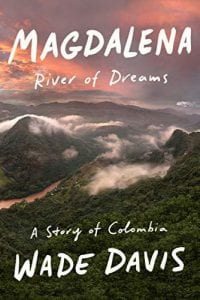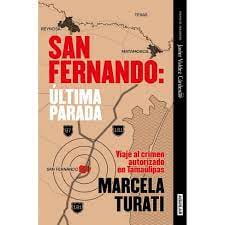A Review of Magdalena: River of Dreams
A Portrait of a River
Wade Davis, a Canada-born ethnobotanist, published a widely praised book in 1996 titled One River. It chronicled the explorations and discoveries of his Harvard professor, Richard Schultes, who sought to understand the origins of mind-altering plants and their ritualistic use by South American indigenous cultures, many of them in Colombia.
Legendary in his field, Schultes (1915-2001) also investigated the jungle plant curare as an anesthetic and participated in the pre-World War II search in the Amazon jungle for new sources of wild rubber. He inspired several of his students to follow in his footsteps, including the late Timothy Plowman, who made extensive studies of coca, the plant source of cocaine, and author Davis, who is National Geographic’s “explorer in residence.”
As Davis points out somewhat immodestly in the preface to his latest book Magdalena, the Spanish translation of One River sold well in Colombia. It highlighted the country’s spectacular geography, biodiversity and native cultures—a positive portrait at a time when any mention of the Andean nation was likely to summon images of Pablo Escobar or violent guerrilla terrorism. A grateful nation made Davis an honorary citizen in 2018, a ceremony officiated by Colombia’s outgoing president Juan Manuel Santos.
Davis admits his new book is a promotional tome, one of a series of guides to Colombian regions underwritten by the conglomerate Grupo Argos, a major producer of cement. The title refers to the 949-mile long Magdalena River, which stretches the length of the country, from its humble source on a windswept southern paramo, until it empties into the Caribbean near the coastal city of Barranquilla. The river’s course and history dating back to its discovery in 1501 by Spanish explorers provide structure for Davis’s book: as he travels northward from the windblown Paramo de las Papas to the humid wetlands where the river joins the ocean, his interviews, anecdotes and social commentary along the way underscore the river’s importance to Colombia’s commerce and culture.
The author’s love and understanding of a nation he began visiting regularly as a high school student in the late 1960s is apparent, and Magdalena could serve as a handy supplement for the increasing numbers of foreign visitors who have traveled here or as primer for those who would like to. A 2016 peace agreement between the government and the largest insurgent group FARC has brought an upsurge in tourists drawn as never before to Colombia’s spectacular geography, wildlife, vestiges of Spanish colonial history and the “magical realism” of its culture popularized by the novels of native son Gabriel García Márquez, despite ongoing guerrilla clashes, murders of social leaders and an uptick in cocaine exports.
In his preface, Davis says his goal is to send “a message to a new generation of Colombians that theirs is not a land of violence and drugs, but a place of unparalleled natural wealth and beauty.” He advances it best with stories about little-known points of Colombian history and culture. One is his brief account of the vapores, the steam-powered paddle wheelers that plied the Magdalena until the 1950s and provided the main source of transport for people traveling from Caribbean coast to the capital Bogotá. The vessels romanticized by García Márquez in his novel Love in the Time of Cholera brought commerce to the river valley by facilitating transport of cotton, tobacco and coffee—but also contributed to its deforestation since the vessels depended on wood for fuel.
There are some delightful vignettes of ribereños, river people, such as Francisco Mesa, a bus driver turned undertaker who moved to Puerto Berrio to seize a ready-made business opportunity: funeral services for victims of Colombia’s violence who had been dumped in the river. (He claims to have fished out 2,000 bodies.) “The Magdalena is Colombia’s biggest coffin,” says one resident. Another vignette involves “manatee avatar” José Manuel Zapata who rallied his local townspeople to provide wild grass to the strange river mammals stranded by drought.
The Magdalena River valley hosts one of the world’s largest cattle herds, Davis points out, thanks to German immigrants who in the 1920s imported the humpbacked Zenu breed popular in India which is resistant to the tropical maladies that attack other strains. He rightly leavens the magic with reality, for example, bemoaning Colombia’s enduring curse of inequality with the sad story of Dameris Mejía, a courageous human rights leader from the river town of Puerto Triunfo who campaigned for land reform and was murdered for her outspokenness.
Those who enjoyed One River may be disappointed to find few insights or anecdotes gleaned from Davis’ vocation of “plant explorer.” Instead, he devotes space to rehashing contemporary history, including a lengthy section on Escobar, as if movie-goers and Netflix-viewers weren’t sufficiently familiar. Ditto, his section on the much publicized urban “rebirth” of Medellin, Escobar’s former home turf.
Distracting and of questionable relevance were his interviews with two former presidents and former Medellín mayor Sergio Fajardo, who is a probable 2022 presidential candidate, none of whom had any apparent connection to the river or to efforts to clean it up. His use of vapid, New Age lingo is sometimes grating, as in a lengthy section explaining the appeal of Afro-inspired cumbia music and dance. He describes the genre as a “choreography of seduction that ignites the spirit and shakes the soul, infusing one’s entire physical being with a sensual promise as innocent and perfect as a prayer.”
As someone who has sounded the alarm for endangered environments and cultures, Davis could have complained more strenuously about the environmental destruction wrought by illegal logging and gold mining on Colombia’s rivers. Seemingly unstoppable outlaw miners use massive jury-rigged dredges to plow up, scar and sluice river beds. They are the evil twins of the mythic paddle wheelers Davis described.
Although he makes a passing reference to proposed dams that would destroy the picturesque Magdalena River canyons of southern Huila province, Davis missed an opportunity to highlight the fiasco of Hidroituango, a $2.5 billion hydro power project on the Cauca River, a Magdalena feeder, that displaced hundreds of farm and fishing families and which went ahead despite geologists’ warnings that it could be compromised by seismic activity. Sure enough, an April 2018 landslide into the reservoir as the dam was nearing completion nearly caused it to collapse, a catastrophe in the making. While the delayed project is now set to open next year, its future integrity and safety is anything but assured.
Land reform advocate Mejía was just one of hundreds of social, environmental and indigenous leaders murdered every year by what the former governor of Arauca province once described to me as “fuerzas oscuras,” sinister forces. And while Davis applauds the government for setting aside indigenous reservations, for encoding multiculturalism in the 1991 constitution, and the Kogi nation of Elder Brothers for inspiring “wonder and hope,” he did not query the former presidents he talked to about the government’s inability to prevent the ongoing slaughter of indigenous leaders who stand up to trespassing drug traffickers and guerrilla groups seeking to recruit their teenagers.
All of which is to say that despite the book’s shortcomings that may limit its value to Colombians, the experiences and anecdotes Davis includes in Magdalena should whet the appetite of foreigners to visit this savage and gorgeous country. Chances are good they will be captivated by the country as was Davis on his life-changing high school trip a half century ago.
Spring/Summer 2020, Volume XIX, Number 3
Chris Kraul is a former foreign correspondent for the Los Angeles Times. Kraul is a freelance writer based in Bogota. He has lived and worked in Colombia since 2006.
Related Articles
A Review of Aaron Copland in Latin America: Music and Cultural Politics
In Aaron Copland in Latin America: Music and Cultural Politics, Carol Hess provides a nuanced exploration of the Brooklyn-born composer and conductor Aaron Copland (1900–1990), who served as a cultural diplomat in Latin America during multiple tours.
A Review of San Fernando: Última Parada, Viaje al crimen autorizado en Tamaulipas
One of Mexico’s best investigative journalists, Marcela Turati, takes readers to terrorized and traumatized San Fernando, a town known for dozens of mass graves, and exposes the depths of criminal brutality and official corruption that hid the bodies and the truth for years.
A Review of Until I Find You: Disappeared Children and Coercive Adoptions in Guatemala
A student in my “Introduction to Cultural Anthropology” course at the University of Delaware approached me several weeks ago, after hearing about my long-term research in Guatemalan communities, to tell me that they were born there, in Guatemala.





